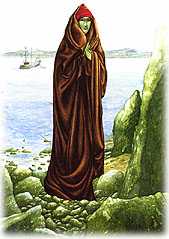|

 The word merrow or moruadh comes from the Irish muir (meaning sea) and oigh (meaning maid) and refers specifically to the female of the species. Mermen - the merrows male counterparts - have been rarely seen. They have been described as exceptionally ugly and scaled, with pig-like features and long, pointed teeth. Merrows themselves are extremely beautiful and are promiscuous in their relations with mortals.
The word merrow or moruadh comes from the Irish muir (meaning sea) and oigh (meaning maid) and refers specifically to the female of the species. Mermen - the merrows male counterparts - have been rarely seen. They have been described as exceptionally ugly and scaled, with pig-like features and long, pointed teeth. Merrows themselves are extremely beautiful and are promiscuous in their relations with mortals.The Irish merrow differs physically from humans in that her feet are flatter than those of a mortal and her hands have a thin webbing between the fingers. It should not be assumed that merrows are kindly and well-disposed towards mortals. As members of the sidhe, or Irish fairy world, the inhabitants of Tir fo Thoinn (the Land beneath the Waves) have a natural antipathy towards humans. In some parts of Ireland, they are regarded as messengers of doom and death.
Merrows have special clothing to enable them to travel through ocean currents. In Kerry, Cork and Wexford, they wear a small red cap made from feathers, called a cohullen druith. However, in more northerly waters they travel through the sea wrapped in sealskin cloaks, taking on the appearance and attributes of seals. In order to come ashore, the merrow abandons her cap or cloak, so any mortal who finds these has power over her, as she cannot return to the sea until they are retrieved. Hiding the cloak in the thatches of his house, a fisherman may persuade the merrow to marry them. Such brides are often extremely wealthy, with fortunes of gold plundered from shipwrecks. Eventually the merrow will recover the cloak, and find her urge to return to the sea so strong that she leaves her human husband and children behind.
Many coastal dwellers have taken merrows as lovers and a number of famous 
